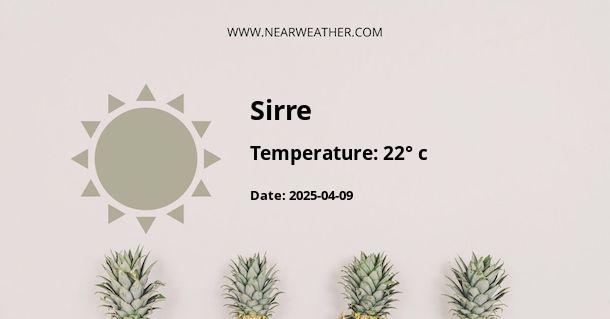Weather
22° 
Climate Conditions: overcast clouds
Humidity: 19%
Wind speed: 17.46 km/h
Wind direction: 69°
Daily Weather Forecast
Wednesday
04/09/2025
Climate Conditions: overcast clouds
Humidity: 17%
Thursday
04/10/2025
Climate Conditions: scattered clouds
Humidity: 23%
Friday
04/11/2025
Climate Conditions: broken clouds
Humidity: 30%
Saturday
04/12/2025
Climate Conditions: overcast clouds
Humidity: 52%
Sunday
04/13/2025
Climate Conditions: light rain
Humidity: 62%
Evolution
Daily Weather Forecast Evolution (°C)
Lowest temperature
Highest temperature
Other Information
Sunrise
06:15
Sunset
18:31
Latitude
8.316670
Longitude
39.483330
Timezone: GMT+05:30
More about Sirre:
Climate and Weather in Eritrea
Eritrea, located in the Horn of Africa, experiences a diverse range of climates and weather conditions throughout the year. From the coastal regions to the highlands, the country's topography contributes to variations in temperature, precipitation, and wind patterns. Understanding the climate and weather of Eritrea can be helpful for travelers and residents alike. In this article, we will explore the different regions of Eritrea and delve into the climate and weather patterns they experience year-round.Coastal Climate
The coastal regions of Eritrea, including the cities of Massawa and Assab, are characterized by a hot desert climate. The region experiences extremely high temperatures, especially during the summer months. Average temperatures can range from 30°C (86°F) to 45°C (113°F), with occasional heatwaves pushing the mercury even higher. The humidity levels along the coast are relatively high, making the heat feel more intense. Rainfall in the coastal areas is minimal, with an average annual precipitation of around 200mm (7.9 inches). The majority of rainfall occurs during the winter months, between November and February, in the form of short but intense showers. The rest of the year remains dry and arid.Highland Climate
The highland areas of Eritrea, such as the capital city Asmara and the surrounding region, have a more moderate climate compared to the coastal areas. The highlands experience a subtropical highland climate, characterized by mild temperatures and distinct wet and dry seasons. During the summer months, from June to September, temperatures in the highland areas average between 20°C (68°F) and 25°C (77°F). However, due to the altitude, nighttime temperatures can drop significantly, reaching as low as 10°C (50°F). The winter months, from December to February, are cooler, with average temperatures ranging from 10°C (50°F) to 15°C (59°F). Rainfall in the highland areas is heaviest during the wet season, which typically occurs from June to September. The region receives an average annual precipitation of around 500mm (19.7 inches). This rainfall is crucial for agriculture and contributes to the fertile soils of the highlands.Central and Eastern Lowlands
The central and eastern lowlands of Eritrea, including the towns of Keren and Teseney, experience a semi-arid climate. This region lies between the coastal areas and the highlands, and its climate reflects this transitional position. The temperatures in the central and eastern lowlands can be quite high, particularly during the summer months. Average temperatures range from 35°C (95°F) to 40°C (104°F) in the hottest months. In the winter, temperatures are milder, but still warm, averaging between 20°C (68°F) and 25°C (77°F). Rainfall in the central and eastern lowlands is limited, with an average annual precipitation of around 200mm (7.9 inches). Most of the rainfall occurs during the summer months, although it is significantly less than what the highlands receive. The dry season extends for the rest of the year, making water scarcity a significant challenge for the region.Wind Patterns
Eritrea experiences distinct wind patterns that influence its climate and weather conditions. The predominant winds are the northeast and southeast trade winds. The northeast trade winds, known as the "Harmattan," blow from the Arabian Peninsula and bring dry and dusty conditions to the region. These winds are most prominent during the winter months and contribute to the dryness of the coastal and lowland areas. On the other hand, the southeast trade winds, known as the "Kaskazi," blow from the Indian Ocean and bring moisture to the coastal areas. These winds are most noticeable during the summer months, providing some relief from the heat and increasing humidity levels.Conclusion
In conclusion, Eritrea experiences a range of climates and weather conditions throughout its different regions. The coastal areas have a hot desert climate with high temperatures and minimal rainfall, while the highlands have a more moderate climate with distinct wet and dry seasons. The central and eastern lowlands lie between these two extremes, experiencing semi-arid conditions. Understanding the climate and weather patterns of Eritrea can help visitors and residents plan their activities and be better prepared for the conditions they may encounter. Please note that the climate and weather patterns described in this article are generalizations and can vary from year to year. It is always advisable to check local weather forecasts and consult reliable sources for the most up-to-date information before traveling to or living in Eritrea.FAQ's about Sirre's Weather:
Q - What is the Latitude and Longitude of Sirre?
A - Sirre's Latitude is 8.316670 & Longitude is 39.483330.
Q - What is the weather in Sirre today?
A - Weather in Sirre is 22° today.
Q - What is the climatic condition of Sirre today?
A - Climate Conditions in Sirre shows overcast clouds today.
Q - What is the humidity in Sirre today?
A - Humidity in Sirre is 19% today.
Q - What is the wind speed in Sirre today?
A - Wind speed in Sirre is 17.46 km/h, flowing at 69° wind direction. today.

Nearby Locations
Latest searched locations